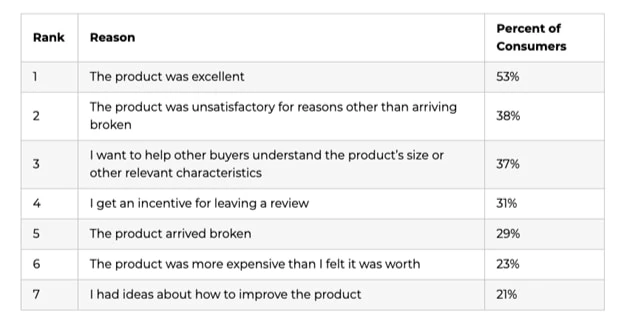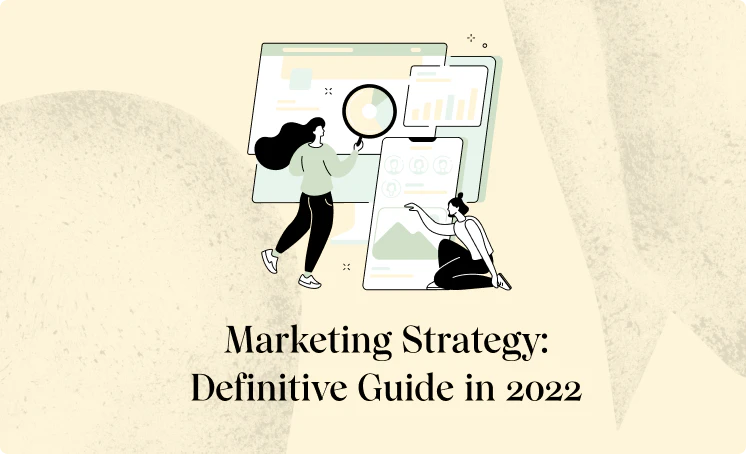Introduction
It doesn’t matter if we’re talking about Google, Yelp, TrustPilot—whatever—customer reviews are a matter of life and death for successful brands.
And on Amazon? Well, reviews help your product appear in more searches, increase your conversion rates, build trust with wary consumers, and compete in a crowded marketplace with over 2.5 million active sellers.
While it’s easy to see why reviews are important, many organizations struggle to get enough of them to move the needle on their sales goals.
In these next few sections, I’ll go over some strategies you can use to start turning things around.
Do Reviews Matter?
Yes. Reviews—both on Amazon and off—matter a lot.
Broadly speaking, they communicate trust, increase brand visibility, and increase sales.
95% of customers read reviews before making a purchase and nearly 70% form an opinion after reading between one and six reviews. Consumers also spend an average of 30% more with brands that have excellent reviews.
94% of customers say that a negative review has convinced them to avoid buying from a specific business and 48% say they’d consider purchasing from a business with fewer than four stars.
Why Do I Need Amazon Customer Reviews?
Unsurprisingly, the same logic that applies to reviews in general extends to your Amazon accounts.
Here are a few examples of customer reviews help Amazon sellers:
- They build trust with consumers. Reviews are one of the fastest ways to let shoppers know that your product lives up to its promise. 84% of consumers trust online reviews as much as a recommendation from a friend, making them an effective tool for convincing shoppers to pull the trigger.
- They increase sales. According to Amazon, a product’s first review can boost sales performance by as much as 350%. Which makes sense–I mean, how often do you choose the product with four reviews over a competing product with 300? Amazon sellers with more reviews and a higher average rating generate more conversions. According to a study conducted by Pattern, conversion rates jumped by about 12% when star ratings increased from a 3 to a 5.
- They’re good for Amazon SEO. Reviews also matter to the Amazon algorithm, which uses customer ratings as a factor in determining ad placement, search ranking, and who gets the buy box.
- • They help you understand your customers. Finally, reviews are a valuable source of customer feedback. They provide direct insight into what customers like (or don’t like) about your products–allowing you to focus on making improvements where it matters.
What’s A Good Sales-To-Review Rate On Amazon?
The average review rate for Amazon products is somewhere around 1-3%.
So, most sellers can expect to see a couple of new reviews per every 100 sales.
Of course “average” and “good” are two very different things.
While there’s no official consensus, sellers might aim to bring that average up to 5% and gradually set more ambitious targets as they start to bring in more reviews.
How To Get Reviews on Amazon: 12 Tips For Capturing Customer Feedback
1. GET TO KNOW AMAZON’S REVIEW GUIDELINES
Okay, this isn’t exactly a strategy, but it’s important to get to know the rules of the game before you start asking your customers for reviews so you don’t inadvertently violate Amazon policy.
Amazon knows that its customers take reviews really seriously. Shoppers rely on others’ opinions to learn more about a product and find out if it’s what they’re looking for.
Amazon’s community guidelines aim to ensure that reviews contain real, unbiased feedback from actual shoppers and prohibits the following.
As such, the following types of reviews are not allowed and will be taken down:
- Reviews written by people with a direct or indirect financial interest in your business—i.e. employees, investors, even the vendors who supply raw materials.
- Reviews written in exchange for a reward—this includes anything from cash payments and gift cards to free products and in-game credits.
- Reviews written by someone with a close relationship to the brand owner/creator—think friends and family.
- Multiple negative reviews from the same person for the same product.
- Leaving negative reviews on a competitor’s product page.
- Swapping positive reviews with other merchants.
Some of these policies like exchanging reviews with other merchants or having friends leave feedback are relatively easy to get away with but you’ll want to be careful.
Amazon’s policy is designed to minimize the number of reviews that mislead or manipulate shoppers. So, anything that stands to undermine consumer trust will be taken down.
Should Amazon find that you’ve been soliciting reviews in ways that violate the community guidelines, it could result in suspension or removal from the platform.
My recommendation: play by the rules. Getting booted from the platform could be a significant blow to your bottom line—with lasting effects you may never come back from.
2. PROVIDE A GREAT CUSTOMER EXPERIENCE
It should go without saying, but the best way to get great reviews is to provide a great experience.
On Amazon, you don’t have a ton of first-hand contact with customers so providing a great experience is more about doing the following:
- Avoiding outages and delays with proper inventory management.
- Responding to comments/questions in a timely manner.
- Making sure product pages, ads, and search queries align around a unified message.
- Ensuring that photos, specs, and copy accurately represent the product customers will receive.
3. SELL GREAT PRODUCTS
Providing a great experience also means offering products that shoppers actually want to buy.
Per Amazon’s e-commerce business guide, a great product should:
- Solve a pain point or challenge
- Improve an activity/function
- Address flaws common in competing products
- Capitalize on trends
You’ll also want to validate your idea with real customers both through market research and individual interviews.
It also helps to understand why customers leave reviews in the first place. According to JungleScout data, Amazon shoppers said they share feedback for the following reasons:

Of course, excellent products are a no-brainer, but some of the other items on this list are telling.
Ideas about how to improve, a desire to help other shoppers understand a product’s size/characteristics, and the product was more expensive than it was worth all point toward a shortcoming on the seller’s end.
That means focusing on sourcing high-quality materials, building and improving products with customer feedback/market insights, and retiring the SKUs that don’t resonate with shoppers.
4. USE AMAZON’S AUTOMATED FOLLOW-UP SYSTEM
It’s important to reach out soon after the customer receives the order when the experience is still fresh in their mind.
At the same time, you don’t want to jump the gun and follow up the second you receive delivery confirmation.
Instead, try using Amazon’s automated follow-up system, which relies on its massive data sets and AI to ensure that email surveys hit customers’ inboxes at the exact right moment.
Recipients receive a generic—albeit straight-to-the-point—email that looks like this:

5. FOLLOW UP WITH AMAZON’S ‘REQUEST A REVIEW’ BUTTON
Amazon’s ”Request a Review” button allows you to follow up with a second review request if a customer doesn’t respond to the automated message. You can find the feature inside your Seller Central dashboard under “Order Details.”
You can only use the button once and it’s only available for a limited time—from 5-30 days after the item was delivered. The benefit here is, sending a second email increases the chances of getting a review.
Still, this method isn’t especially efficient–you can’t automate a second round of follow-ups from Amazon, so there’s the risk that you’ll miss out on easy opportunities to score more reviews.
Instead, you may want to look into an autoresponder tool, which allows you to automate your follow-ups.
A few options:
6. ENROLL IN ONE OF AMAZON’S PROMOTIONAL PROGRAMS
Amazon recently ended its popular Early Review program and replaced it with One Tap Reviews and Global Review Sharing—programs rumored to be an attempt at burying fake reviews.
One Tap Reviews officially launched last October and are designed to collect shopper feedback in single click. Customers now have the option to leave a star rating and skip the written part. So far, the number of reviews per product has increased dramatically—with many of the top 100 listings featuring over 10k reviews.
Global review sharing essentially just means you’ll see reviews from other countries—if you’re part of the Amazon Global Selling program, that is.
If you’re looking for a more active way to get more action on the platform, here a few options that might help:
- Amazon Vine is an invite-only program designed to help sellers collect unbiased, honest feedback from trusted reviewers.The idea is, Amazon reaches out to shoppers who share feedback regularly —and whose responses are consistently voted as being valuable by other users—-and invites them to become a Vine Voice. Participants receive free products in exchange for their time.
- Amazon Launchpad. If you’re a startup, you might want to look into Amazon Launchpad, a program that offers increased exposure for new brands and waived fees on special offers. While it’s not specific to review generation, Launchpad does provide a lot more visibility than those enrolled as a standard seller.
- Subscription Boxes. Amazon subscription boxes provide another opportunity to get new products in the hands of shoppers. While sellers are on the hook for assembling and packaging the boxes themselves (FBA won’t do it), the experience of opening a curated box of goodies each month will surely net you some reviews.
- Amazon Custom, a store on Amazon dedicated to custom products shoppers can customize with images, logos, or text. These products are also cross-posted to the main Amazon website, as well as the appropriate categories/sub-categories—presenting additional opportunities to reach more people and provide a personalized experience. A lot of what you’ll find here is personalized pet accessories like ID tags and bowls, wedding stuff, and gifts.
Note: Amazon FBA is currently not available for customized products. If you’re an FBA user, it’s worth considering whether it makes sense to keep some extra inventory on-site so that customization is an option.
7. USE PRODUCT INSERTS
Another way to encourage customers to share feedback is by including product inserts in your shipments. Product inserts typically include the following information:
- Company contact details
- A request for feedback—often, this includes a QR code that directs customers to the appropriate page
- Product instructions
Now, I should mention that packaging inserts have notoriously low conversion rates. But, they do help contribute to overall brand awareness and they can enhance the brand experience.
Here, it might be worth investing in some professional design. Your goal is to capture customers’ attention–something that’s admittedly hard to pull off with a promotional piece of cardstock.
Make sure you avoid asking customers to “leave a five-star review” or offer an incentive in exchange for leaving feedback. You might instead try something short and sweet like this thank you message below:

8. STAY ON TOP OF YOUR REVIEWS
Monitoring customer sentiment is a super important part of your review strategy.
Treat reviews—good or bad—as a two-way dialog with your customers.
Your goal is to be receptive and show reviewers that:
A: you’re listening
and
B: you’ll use that feedback to do better in the future
Carve out some space in your schedule to monitor incoming reviews and be sure to respond ASAP. You don’t want to let negative feedback fester—there’s a real risk that the customer will get frustrated and air their grievances on other channels.
In other words, a customer who feels ignored might tweet about their experience in retaliation and amplify that complaint.
Beyond the damage control aspect, quick responses to negative feedback may actually increase shopper intent.
According to one study, shoppers who read seller responses to bad reviews were 186% more likely to buy from that brand than those who didn’t read the reviews. Most customers understand that things sometimes go wrong—and when a brand shares a thoughtful response with a quick turnaround it demonstrates that they’re active and invested in the customer experience.
New visitors will also see how you respond to negative feedback—and even if there are some negative reviews here and there—they’re likely to walk away with a favorable impression of your brand.
Now, you’ll have a few different options for managing reviews.
Inside Amazon Seller Central. The Customer Reviews page on the Brand Dashboard allows brands to manage customer reviews across all SKUs.
You can:
- Correct issues with your listings based on customer feedback
- Answer questions
- Respond to negative feedback
- Identify and report abuse
Do note, this option is only available to sellers who own their brand.
Meaning, it’s not available to merchants that sell other brands’ products—whether they’re drop shipping or handling inventory themselves.
Social listening/reputation management tools
For sellers who are managing multiple channels, it makes more sense to use a social listening tool to keep a pulse on the customer conversation rather than relying on the Amazon dashboard alone.
Here are some top-rated options that integrate with Amazon:
Comprehensive experience management tool that allows you to measure
9. USE PPC AND PAID SOCIAL TO FEED YOUR CUSTOMER REVIEW STRATEGY
More sales mean more people will leave reviews and the more reviews you have on your listings, the more sales you’ll generate.
Once you’ve got an established presence on Amazon, reviews will start to do the heavy lifting on their own. That said, it’s hard to establish that momentum if you’re new to the platform or are launching new products.
That’s where advertising comes in.
No matter how great your products are, sometimes you need to take matters into your own hands and point shoppers in the right direction.
Amazon Ads (Best for Attracting Active Amazon Shoppers)
The most obvious choice here is using Amazon Ads to promote Amazon listings.
Sponsored product ads work best in cases where you’re trying to reach shoppers who are already on the platform. Sponsored products are about making sure your product is in the “right place at the right time” so active users can discover them.
Make sure you use the targeting options to get in front of the right shoppers.
Amazon Ads can’t do much for you outside the platform, so you’ll want to leverage your socials to bring in some external traffic.
Social Media Ads (Best for Reaching Inactive Customers in Your Target Market)
According to a recent JungleScout report, 21% of shoppers begin their search on social media, making it a critical part of driving targeted users to your listings.
What’s great about using a channel like Facebook, you can reach users who aren’t actively shopping on Amazon or searching for specific items on Google.
While the passive nature of social scrolling means you have to work harder to capture users’ attention, you can get real specific with your targeting:
- Demographics: location, income, age
- Lookalikes: people that share characteristics with your existing customers
- Interests: Hobbies, music, TV, movies, books, etc.
Additionally, Facebook allows you to capture way more customer feedback than Amazon. You can create lead-gen forms that capture email addresses or ask them to opt in to Messenger communications.
If you’re trying to bring shoppers to Amazon, you’ll want to use a landing page, as Facebook users will have much lower buying intent than their counterparts on Amazon.
Embed a link to an Amazon landing page where you can collect contact details and showcase your products.
You can also run A/B tests on copy, images, and ad types and learn how ads perform with different segments. All the data you collect can help you optimize your Amazon listings and refine your on-platform ads so you’ll get better results.
10. OPTIMIZE AMAZON LISTINGS FOR PURCHASE INTENT
Here’s a basic overview of how to optimize listings for Amazon (we go over this in more detail in a separate post, if you’d like to learn more) so that users can find what they need:
Now, Amazon’s A9 algorithm is designed to surface the products shoppers are searching for. All searches are commercial, rankings are based on the likelihood of purchase–which is determined by the following factors:
- Text match: Using the keywords that reviewers include in their write-ups can increase your listing’s text match relevancy–which can both improve your Amazon SEO performance and help you demonstrate that your product is exactly what shoppers are looking for.
- Price: Is your price competitive?
- Availability: Do you have products in stock?
- Prime status: Are you Prime eligible?
- Ratings & reviews: What’s your average rating? How many reviews do you have?
- Images & video: Do images/videos match the copy, provide a clear picture of the product?
11. CREATE A MAILING LIST AND ASK CUSTOMERS FOR REVIEWS
The people who subscribe to your newsletter probably like something about your brand and there’s a good chance they’ve purchased from you in the past, making them a great source of positive reviews.
You can build an email list from Amazon, then send information about your product and a link to that specific listing.
Keep in mind, the response rate will likely be pretty low.
Assuming that your email gets a 1% conversion rate and only about 2% of sales generate a review, you’d need to email 10,000 people to get just two reviews.
That doesn’t necessarily mean you should write off this strategy.
My recommendation is that you automate the process and use email responder tools that include features like dynamic personalization and automated sequencing–ActiveCampaign, Campaign Monitor, MailChimp are a few that come to mind. This will save you a ton of time and get better results than manual, ad-hoc strategies.
Or, you might try using Messenger instead. The idea is the same–you’re building a list of subscribers by obtaining active consent, though Messenger bots provide a more interactive experience.
According to Mobile Monkey, Facebook Messenger bots receive ~20% open rates and 2% click-throughs.
12. REACH OUT TO USERS WHO REVIEWED SIMILAR PRODUCTS
By looking at feedback from shoppers who purchased competitors’ products you’ll get a clearer sense of what brands are getting right — or horribly wrong — about their products and the service they provide.
Another idea is reaching out to people who have reviewed similar (read: competitor) items in the past.
You can find them by navigating to your product page, then scrolling to the bottom of the page. Look at the products featured in the “Customers Who Bought This Item Also Bought” and “Customers Who Viewed This Item Also Viewed” sections.
Click a product, then click customer reviews and sort by “most recent:”
Click the reviewer’s name for their details–some customers include contact info on their public profile.
If there’s an email address, send them an email—otherwise, you might try contacting them on other channels like Facebook, Twitter, or Instagram.
A couple of things to note:
1. Contacting random users is hard to pull off. The whole reason Amazon created the “Request a Review” button in the first place was that shoppers were getting way too many unsolicited emails from sellers.
So, if you’re going to message people who bought products similar to yours, you’re going to really need to think hard about your messaging and really focus on providing value.
For example, you might try filtering out one or two-star reviews or specific tags and inviting customers to try your products–assuming your product addresses the issues mentioned in the review. In that case, you’re not asking for a review directly, rather guiding them to a product that better addresses their needs.
2. Most people don’t share their contact details. Unlike LinkedIn or Facebook, Amazon users often use nicknames and don’t upload profile pictures. Some do, but overall, scraping the platform for email addresses might not be the best use of your time.
Finally, competitor products and reviewer profiles are really useful research tools.
You can find out what people like, what they don’t like, and capture specific feedback for how you can do better than what’s already out there.
While this might not result in an immediate uptick in reviews, those insights can help you improve your product and overall experience–which long-term, will net you more reviews.
13. CHECK YOUR SELLER FEEDBACK
While it’s more common for customers to leave feedback on individual product pages, many people opt to share their thoughts in the Seller Feedback section on your profile.
You’ll want to make a habit out of checking your Seller Feedback for a few reasons.
1. It’s an opportunity to earn a second review. If you find positive comments on your seller page, you might ask that person to share their experience on the product page as well.
If you see any reviews mentioning a specific product, reach out to the customer, thank them, and ask if they’re willing to share that information again on the product page. Again, you’re more likely to get a response if you reach out ASAP.
2. It prevents critical feedback from falling through the cracks. Customer complaints, requests for a specific product, suggestions for making improvements can all help you improve your performance on the platform and win some repeat customers. If you’re not paying attention, you might miss the important insights hiding out on your profile page.
3. It allows you to report negative product reviews. Bad product reviews don’t belong on the seller page. If you find one in your Seller Feedback, you can reach out to Amazon and they’ll take it down. While it’s not okay to ask customers to remove product reviews, Amazon will remove product reviews posted in the wrong place as they’re not helpful to the customer experience.
Amazon Customer Reviews: Dos And Don’ts
Do:
- Focus on the customer. Remember, positive reviews are the result of a positive experience. If you focus on creating products customers love, exceed expectations, and make an effort to stay fresh in their minds–chances are, you’ll start to see more five-star ratings.
- Develop a review generation strategy. Again, a lot of this comes down to consistency: following up on every order, responding to customer feedback in a timely manner, and establishing a recognizable presence–on Amazon and off.
- Keep discounts to a minimum. Adding discount offers to your customer review requests can come off soliciting reviews.
- Use review feedback to improve. Look, it can be hard to receive negative feedback but it’s important to take a step back and think of it as an opportunity to improve.
Don’t:
- Buy reviews. It doesn’t matter if you hire fake reviewers or offer your employees cash bonuses for sharing some kind words–fake reviews manipulate customer perception.
- Offer incentives. Even if you’re not buying reviews outright, incentivizing reviewers is against Amazon community guidelines.
- Ask friends and family to leave a five-star review. Another example of soliciting reviews–getting your friends and family to
- Ask customers to change their review or take it down. Avoid asking customers to take down negative reviews. Your best bet is helping them solve the problem–which in many cases, will prompt them to update the initial review on their own. Additionally, customers expect to see a handful of negative reviews–and are likely to think that a seller with only five star ratings is gaming the system.
- Pick and choose reviews. Amazon doesn’t allow sellers to “cherry pick” reviews. Meaning, you can’t exclusively solicit reviews from people you already know had a positive experience with your brand while ignoring customers you believe had neutral or negative experiences.
- Use manipulative language. Make sure you ask for feedback in a neutral way–don’t ask customers to share “five-star reviews,” instead, ask them to share their feedback and make it easy for them to do so.
Desired Outcome
The target outcome is pretty straightforward: you’re trying to generate more reviews–without violating Amazon’s terms of service.
Ultimately, review generation comes down to a few key components: creating a great experience, asking for reviews, and using the feedback to drive improvements and nurture relationships with your customers.
Final Thoughts
At a certain point, your customers are in control of your brand’s narrative.
It’s up to you to provide great service, high-quality products, and gently guide them toward sharing feedback about their experience.
Assuming you’ve done everything right, they should only have nice things to say. And if they don’t? Apologize, make it right, and use any criticism you receive to improve.














.webp)

.webp)








.webp)









































.webp)






